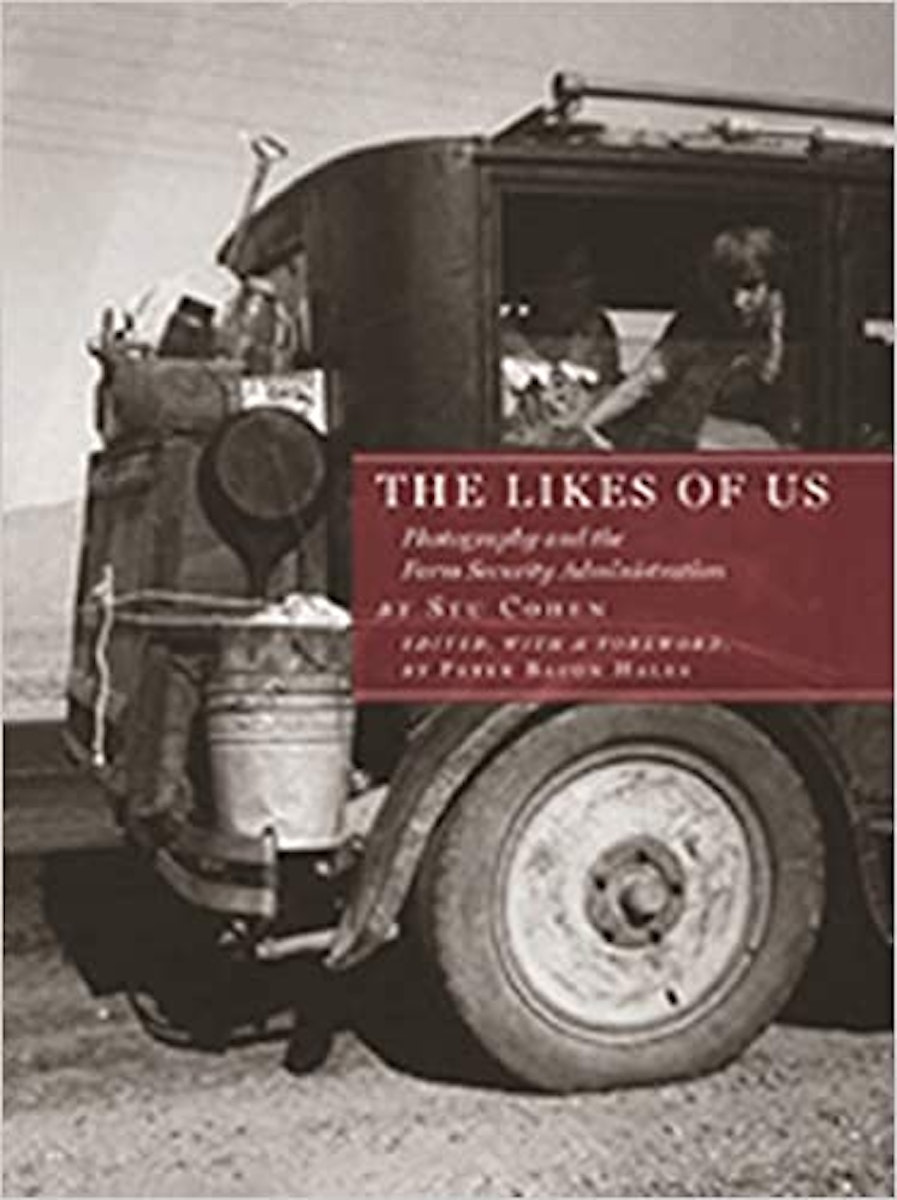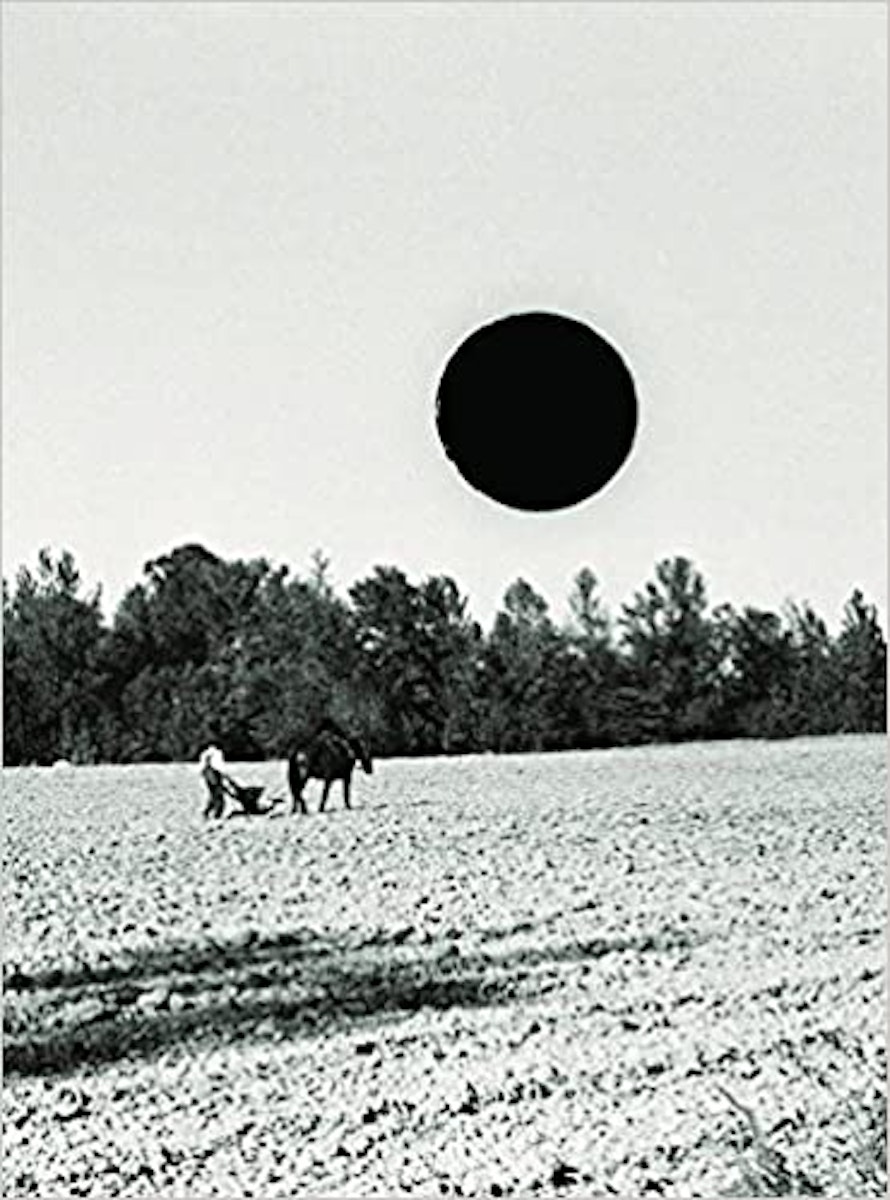
The Kept and the Killed
Of the 270,000 photographs commissioned by the US Farm Security Administration to document the Great Depression, more than a third were “killed”. Erica X Eisen examines the history behind this hole-punched archive and the unknowable void at its center.
January 26, 2022
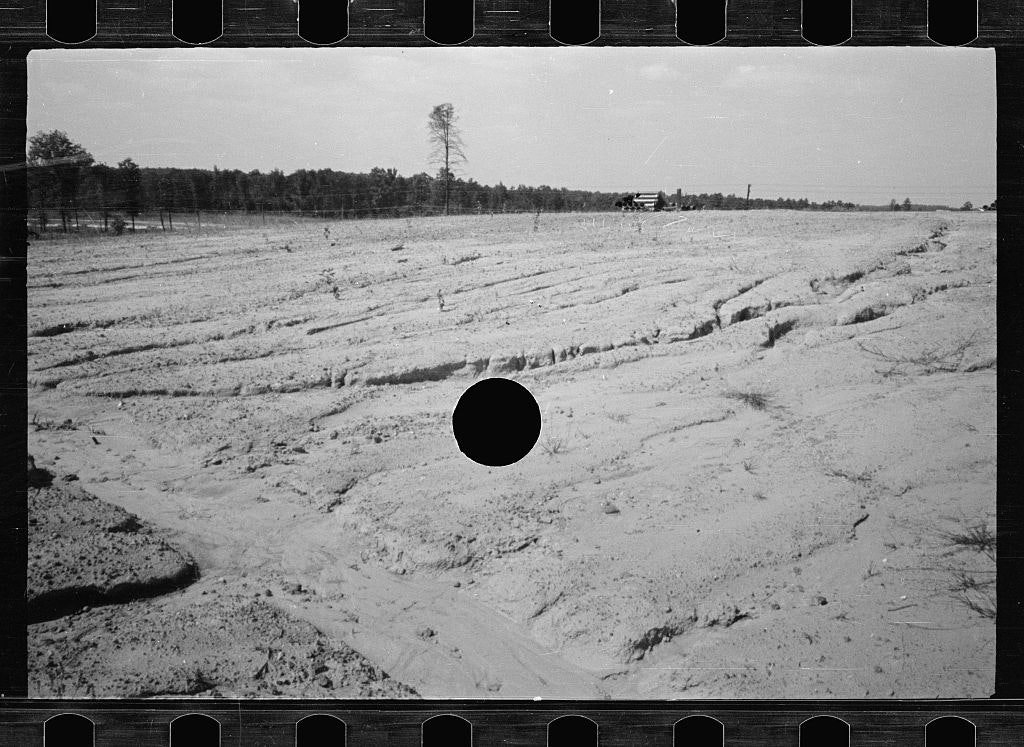 Scroll through the whole page to download all images before printing.
Scroll through the whole page to download all images before printing.Untitled photograph by Carl Mydans, 1935, possibly depicting a farm in Prince George's County, Maryland. One of the so-called "killed negatives" that were hole punched by FSA staff to indicate that they should not be printed — Source.
The first killed negative I encounter is of a field. It’s a Carl Mydans shot, and a drought has reduced the land to a flat, cracked expanse out of which only a few tenacious scraggles of crabgrass have managed to sprout. Nothing notable here, no action, no grand geometries — except that the center of the negative has been pierced by a perfect circle, as though in counterpoint to the sprocket holes running along the photo’s edge. Briefly I imagine that this circle is what has doomed the land, a well into which all the precious waters must have run. Months after coming across the photograph, it is that void, more than any peripheral scenery, which remains anchored in my memory — that and the caption describing the picture as “killed”.
Begun as part of the alphabet soup of Franklin D. Roosevelt’s New Deal policies, the Farm Security Administration (FSA), under the aegis of which Mydans’ ill-fated photo was taken, had been tasked with resettling struggling farmers onto more fertile ground, providing education about agricultural science, and giving loans for the purchase of land, feed, and livestock. Arguably its most enduring legacy today, however, is the hundreds of thousands of photographs the agency1 produced to document the plight of destitute farmers, many of whom were trapped in an inescapable pit of debt made deeper still by the environmental devastation of the Dust Bowl. The project’s head, Roy Emerson Stryker (1893–1975), would shop his favorites around, going from newsroom to newsroom “with pictures under his arm”, as Dorothea Lange would later recall, in an attempt to secure placements in major papers.2 Stryker had encyclopedic ambitions: tasked with the mission of “introducing America to Americans”, the FSA’s photography wing would soon see its remit balloon far past images of rural poverty to encompass everything from aerial shots of utopian building projects to Kodachrome still lifes — all of which could find a home within what Stryker called simply the File.3
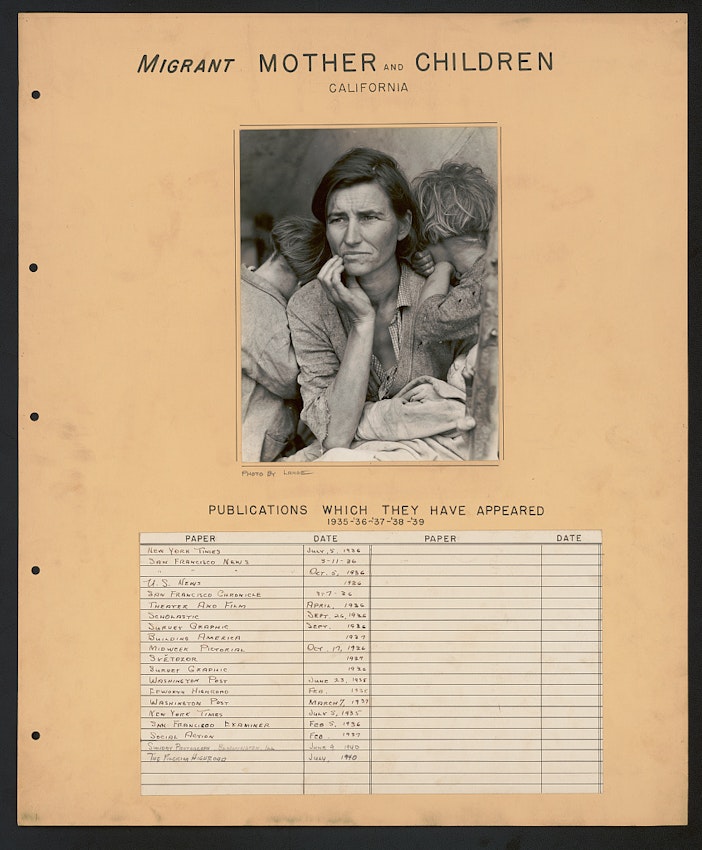 Scroll through the whole page to download all images before printing.
Scroll through the whole page to download all images before printing.A log sheet from the Farm Security Administration, tracking which newspapers and periodicals published Dorothea Lange’s Migrant Mother in the late 1930s — Source.
Yet despite the File’s colossal scope, there were still images that Stryker deemed unfit for inclusion. These photographs had to be, in his parlance, “killed” — marked for exclusion, usually with a merciless hole-punch through the middle. By the time the project came to a close, the FSA’s photographers had captured some 270,000 images, of which a staggering 100,000 were killed.4 These include work by pioneering Black filmmaker and photographer Gordon Parks; by Russell Lee, who would go on to document the internment of Japanese Americans during the Second World War; by Marion Post Wolcott, the FSA’s first full-time female photographer. They also include images of which not even a punctured trace survives. Stryker only used the hole-punch method on 35mm negatives; when presented with sheet film he felt was unsuitable, he simply discarded it.5
Stryker’s career had a ping-pong trajectory: he dropped out of the Colorado School of Mines to become a rancher before being shipped off to fight in World War I, then returned to the U.S. and studied economics at Columbia. There, he researched utopian socialism with Rexford Tugwell, a professor whose emphasis on the pedagogical and psychological impact of visual aids left an impression on Stryker. After Tugwell became part of Roosevelt’s “Brain Trust” of key advisers, he called upon his former student to join him in Washington and head up the photography arm of the Resettlement Administration, which, in 1937, was folded into the Farm Security Administration.6 Though not a photographer himself, Stryker nevertheless had a clearly defined sense of the medium as an instrument of social action and knew what he liked and did not like in an image. He would often send his photographers into the field armed with pages-long scripts detailing what exactly he wanted them to capture, itemized lists that sometimes approached aphoristic form: “The baseball diamond as an important part of our general landscape”; “Pressed clothes”; “The wall decorations in homes as an index to the different income groups and their reactions”; “Old tires piles”; “(What will happen to the roadside hamburger stand?)”; “Pictures of men, women, and children who appear as if they really believed in the U.S.”7
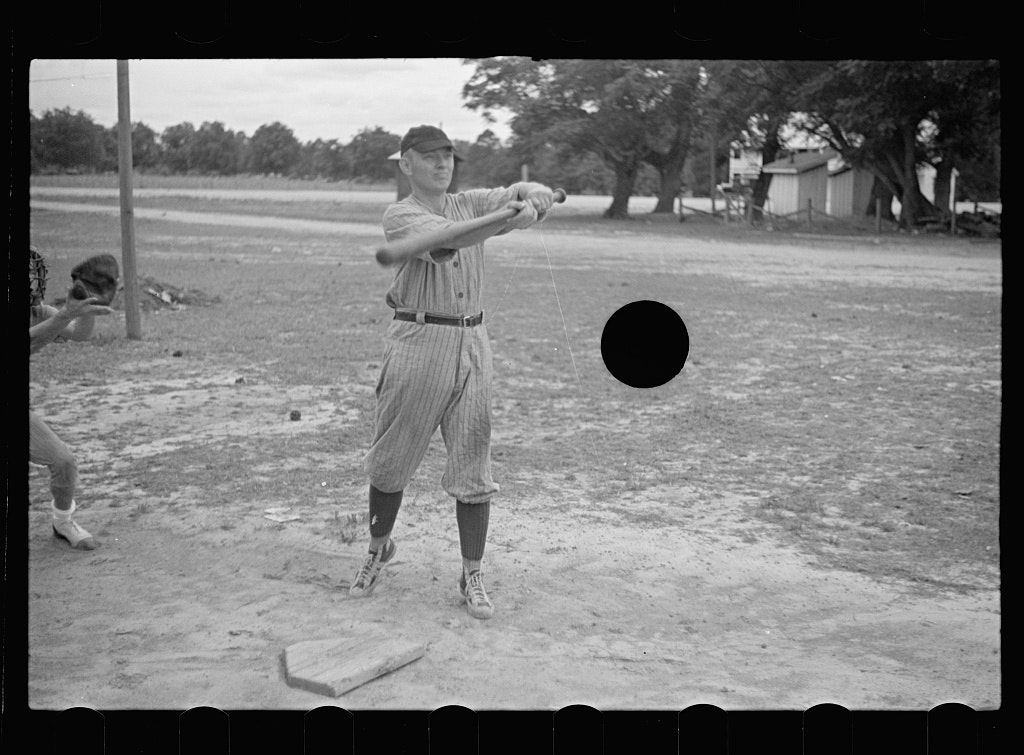 Scroll through the whole page to download all images before printing.
Scroll through the whole page to download all images before printing.Untitled photograph by John Vachon, 1938, possibly related to a series captioned “Ball team at Irwinville Farms, Georgia” — Source.
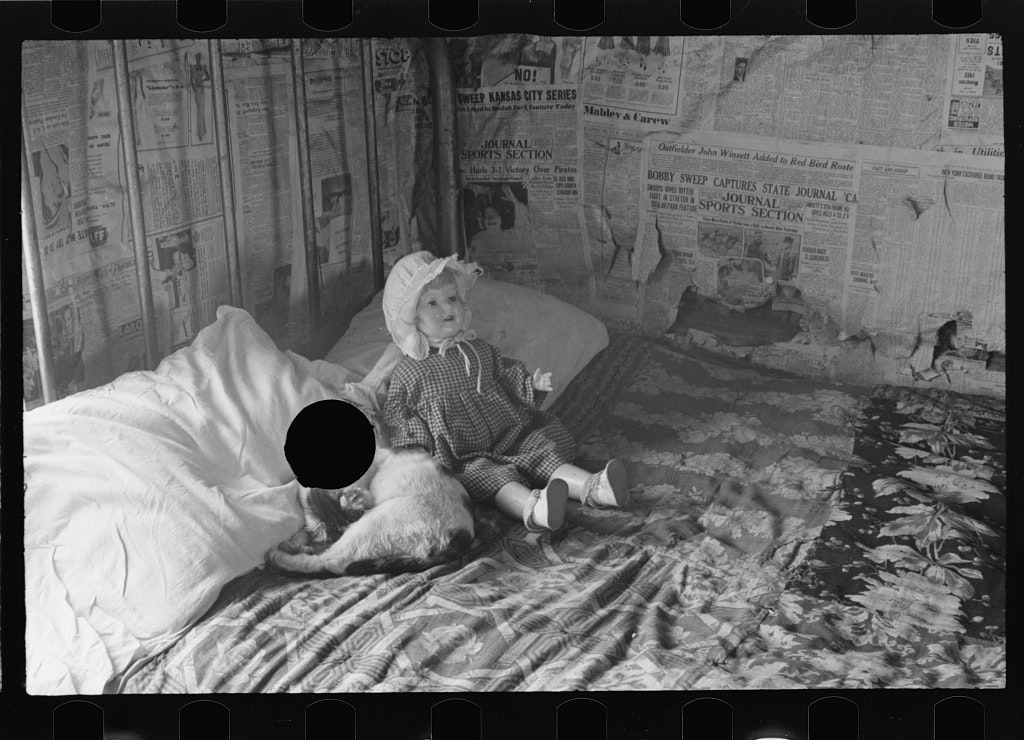 Scroll through the whole page to download all images before printing.
Scroll through the whole page to download all images before printing.Untitled photograph by Theodor Jung, 1936, of the “interior of rehabilitation client's cabin" in Jackson, Ohio — Source.
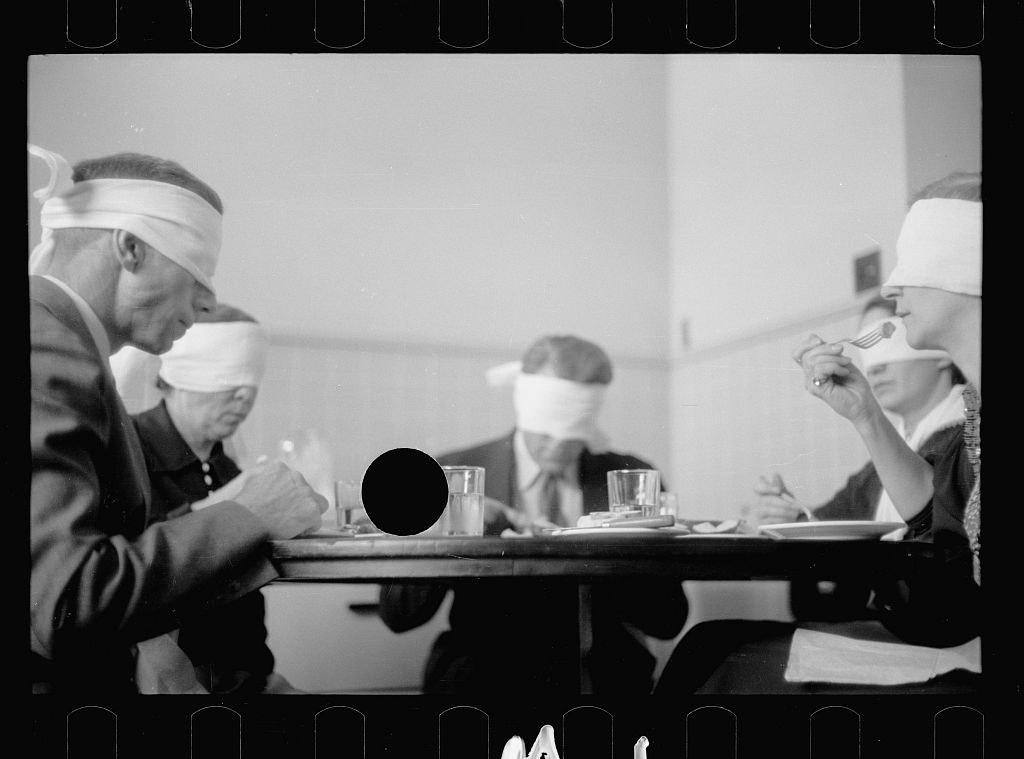 Scroll through the whole page to download all images before printing.
Scroll through the whole page to download all images before printing.Untitled photograph by Carl Mydans, 1935, of "meat testing" in Prince George's County, Maryland — Source.
Stryker’s editorial philosophy occasionally brought him into conflict with the photographers he employed. His refusal to use the captions Lange painstakingly composed for her own images greatly frustrated her (despite praising Migrant Mother as the pinnacle of the FSA photography program’s output, Stryker would fire Lange on three separate occasions).8 Photographer Edwin Rosskam remarked bitterly that Stryker’s hole-punching habit “was barbaric to me. . . I'm sure that some very significant pictures have in that way been killed off, because there is no way of telling, no way, what photograph would come alive when”.9 Another FSA staffer, Ben Shahn, referred to Stryker’s style as “a little bit dictatorial”:
He ruined quite a number of my pictures. . . . Some of them were incredibly valuable. He didn't understand at the time. . . . Later on, during the war . . . I went to look for [a] negative and he[‘d] punched a hole through it. Well, I shot my mouth off about that. But, I didn't know what was done with a lot of my negatives, naturally. He learned, then, not to do that, you see, because this was an invaluable document of what life was like in 1935 and when I was looking for it in 1943 or '44 it didn't exist anymore.10
A chastened Stryker eventually granted veto power to photographers over which of their images would be killed.
By the time he took a job at the Pittsburgh Photography Library in the 1950s, Stryker had transitioned to indicating killed negatives by having them pasted onto cards marked with an incongruously cutesy blue star. Sometimes, however, the old temptation for more abrasive methods seemed to take hold — other cards were branded by a special KILL stamp. In still other cases the destroying angel seems to have taken Stryker over completely and caused him to slash across the doomed images in marker.11 Even those pictures that he favored were not immune from these kinds of interventions: squiggles, lines, and written notes instructed his employees to crop and straighten, addenda that sometimes smudged and marred the photo Stryker was trying to perfect.12
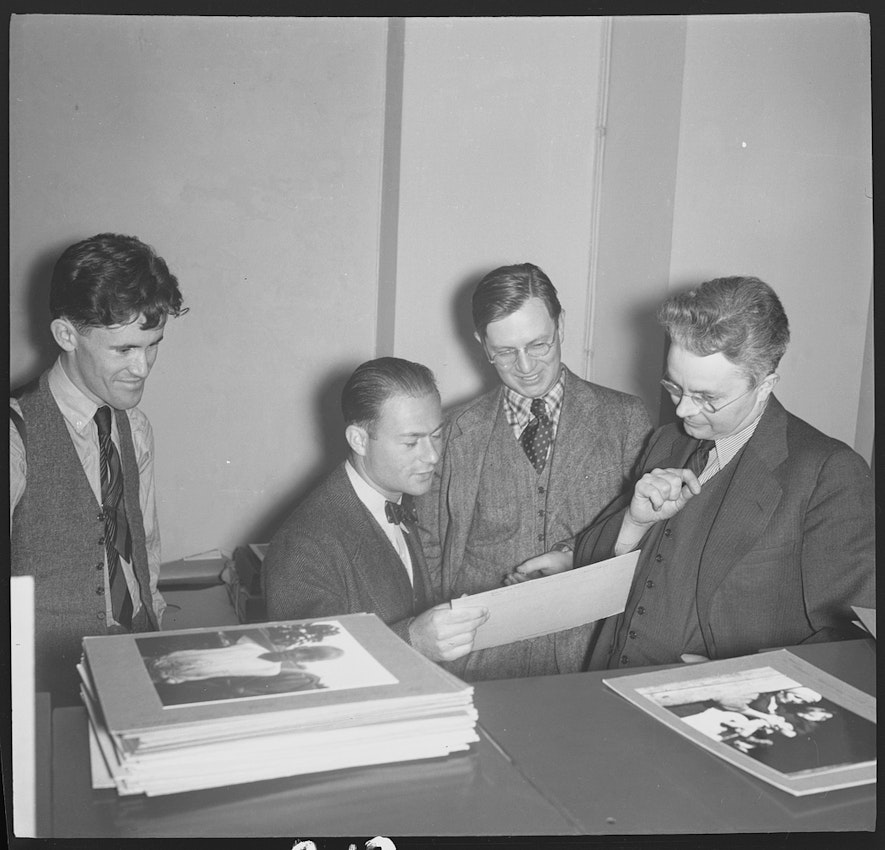 Scroll through the whole page to download all images before printing.
Scroll through the whole page to download all images before printing.Beaumont Newhall’s photograph of Roy Stryker (far right) reviewing photographs with Russell Lee, Arthur Rothstein, and John Vachon (leftmost), ca. 1938 — Source.
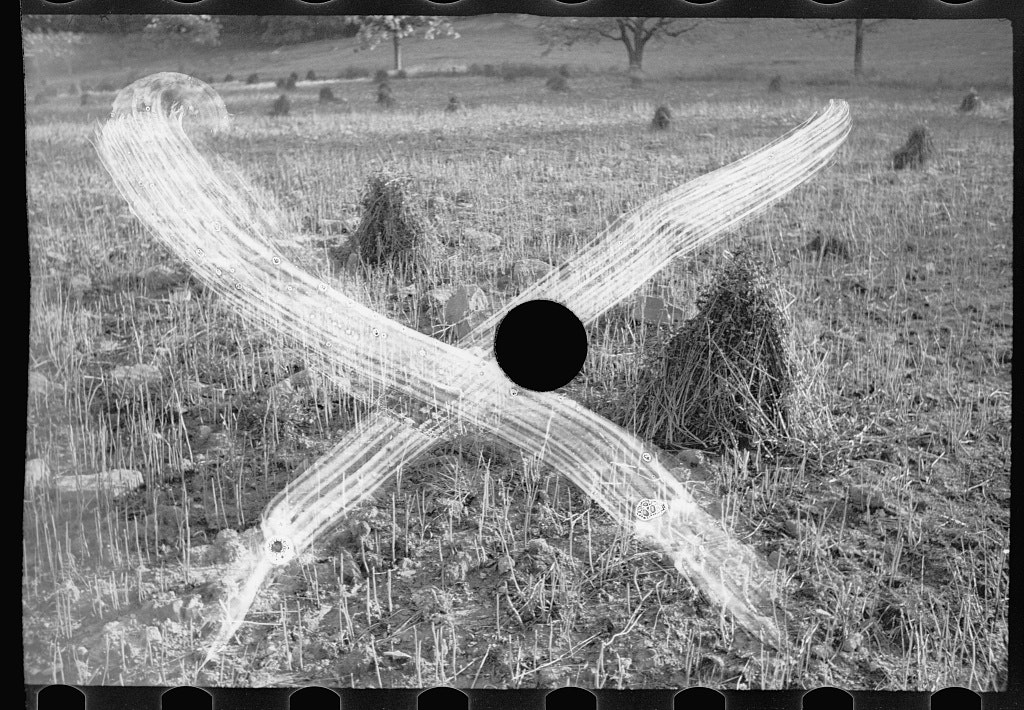 Scroll through the whole page to download all images before printing.
Scroll through the whole page to download all images before printing.Untitled photograph by Theodor Jung, 1935, possibly related to a series captioned “Farmland, hillside type, thoroughly worked, Garrett County, Maryland” — Source.
Most of the negatives Stryker killed, by all accounts, were redundancies nixed in favor of a similar image with stronger composition, clearer focus, and facial expressions better comporting with the themes of suffering and endurance he sought to draw out of the FSA’s subjects. Shot through, these unloved alternates have become almost more interesting than their perfect twins. In contrast to the carefully captioned File images, killed negatives have no names attached, often no notes on provenance: what little we know about them is only by analogy to those photos that were saved, clues about location gleaned from landscapes, clothing, faces. As such, the killed photos demand a more active viewer, one willing to piece together, to parse, to consign some things to the realm of the curious and unknowable.
Did Stryker give much thought as to where to put the hole through when he made his killings? These voids obliterate the hand of a little boy in fringed gloves who stares back calmly at his shooter; they slice through the pavement of an unnamed street where a pair of identical twins walks on unawares. They run like a sniper’s bullet through the legs of a man bending over to pick a fruit, whizz past the ear of a cop. A black hole tarnishes the pale lapel of a floppy-bonneted woman as she looks the other way; it hovers over a man’s head like a grim fate narrowly avoided. In one rare example, a vicious flurry of perforations strafes an entire family of Arkansas sharecroppers as the mother tends to her youngest. The void slates houses for destruction, theaters, water pumps, a cotton bale straining at the corset of its ties. It hangs aloft and lightless over a Chocowinity field like a sun negated. The same person is killed and killed again, from one picture to the next. When one views these photos as a series, the holes begin to feel like a vengeful god too terrible to figure. Once capturing social history, these images now seem to conjure that moment just prior to disaster: before the hole shatters the glass, pops the tire, forces the horse to give one final whinny, kick out uselessly, and fall to the earth.
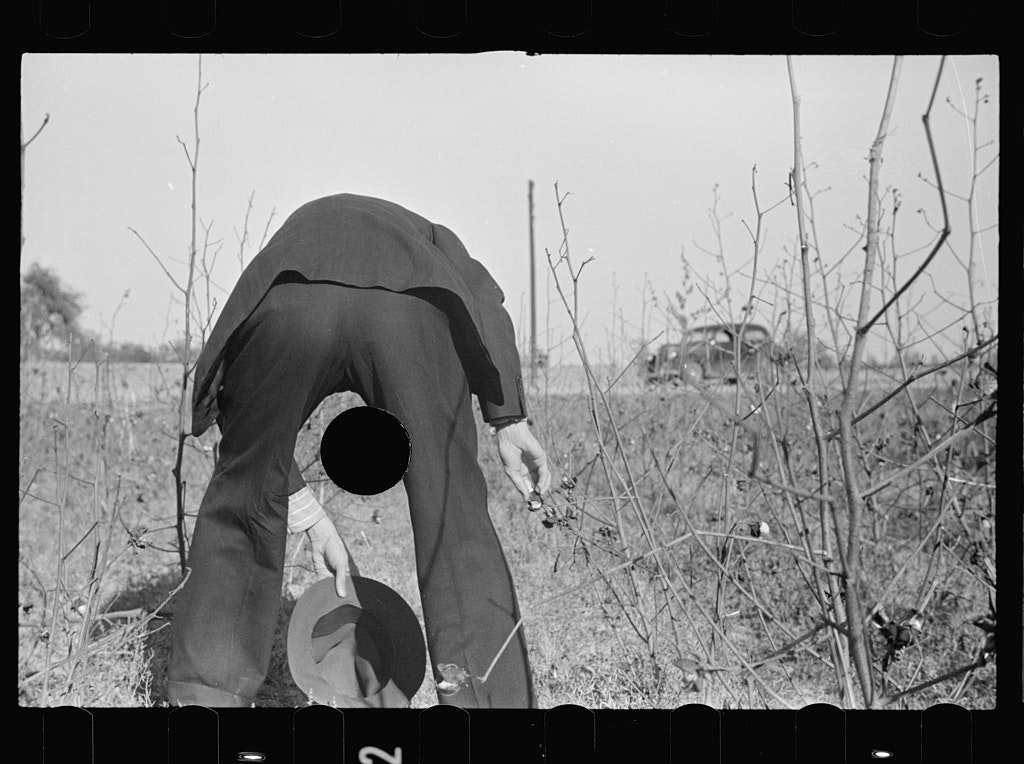 Scroll through the whole page to download all images before printing.
Scroll through the whole page to download all images before printing.Untitled photograph by John Vachon, 1938, taken on Roanoke Farms, Enfield, North Carolina — Source.
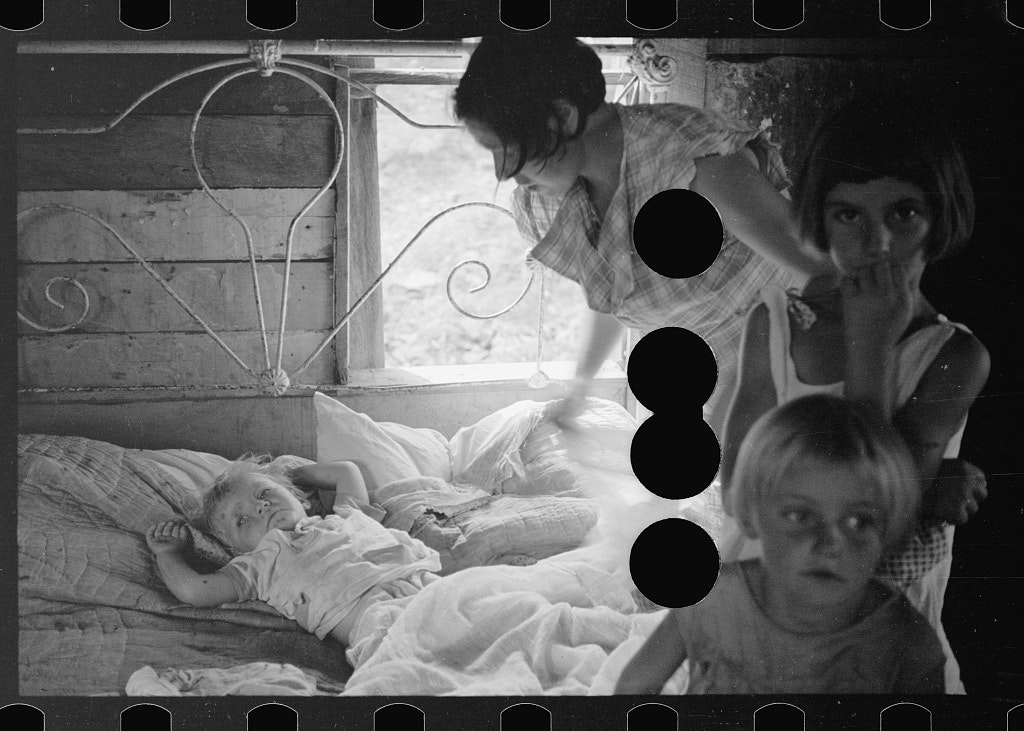 Scroll through the whole page to download all images before printing.
Scroll through the whole page to download all images before printing.Untitled photograph by Arthur Rothstein, 1935, related to a series of images captioned “Sharecropper’s wife and children, Arkansas” — Source.
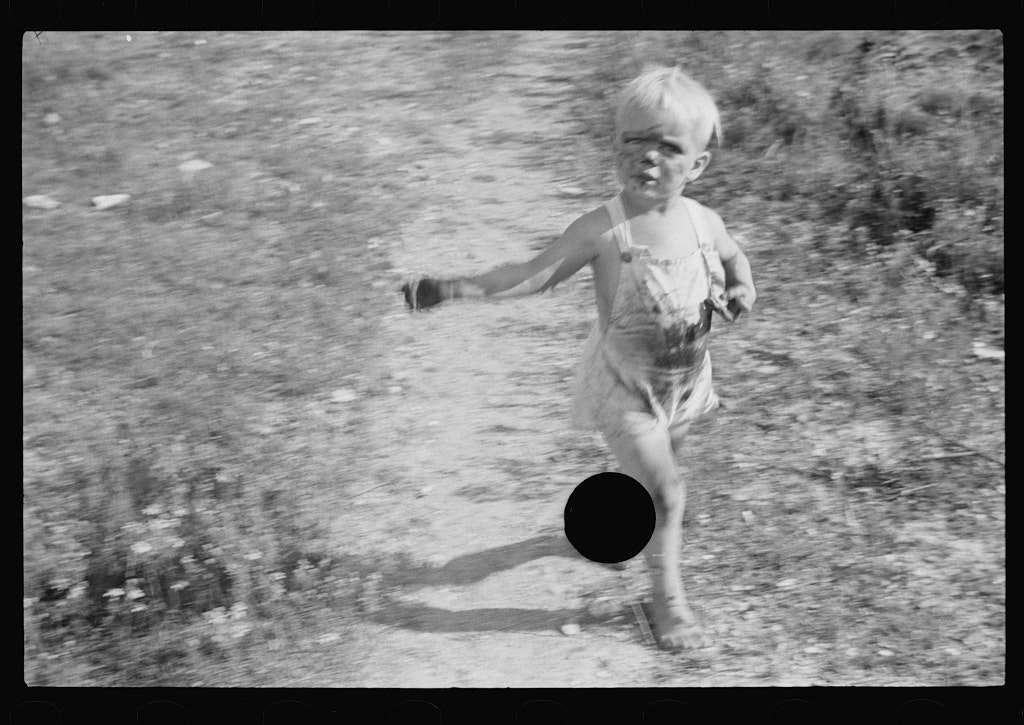 Scroll through the whole page to download all images before printing.
Scroll through the whole page to download all images before printing.Untitled photograph, unknown photographer and date — Source.
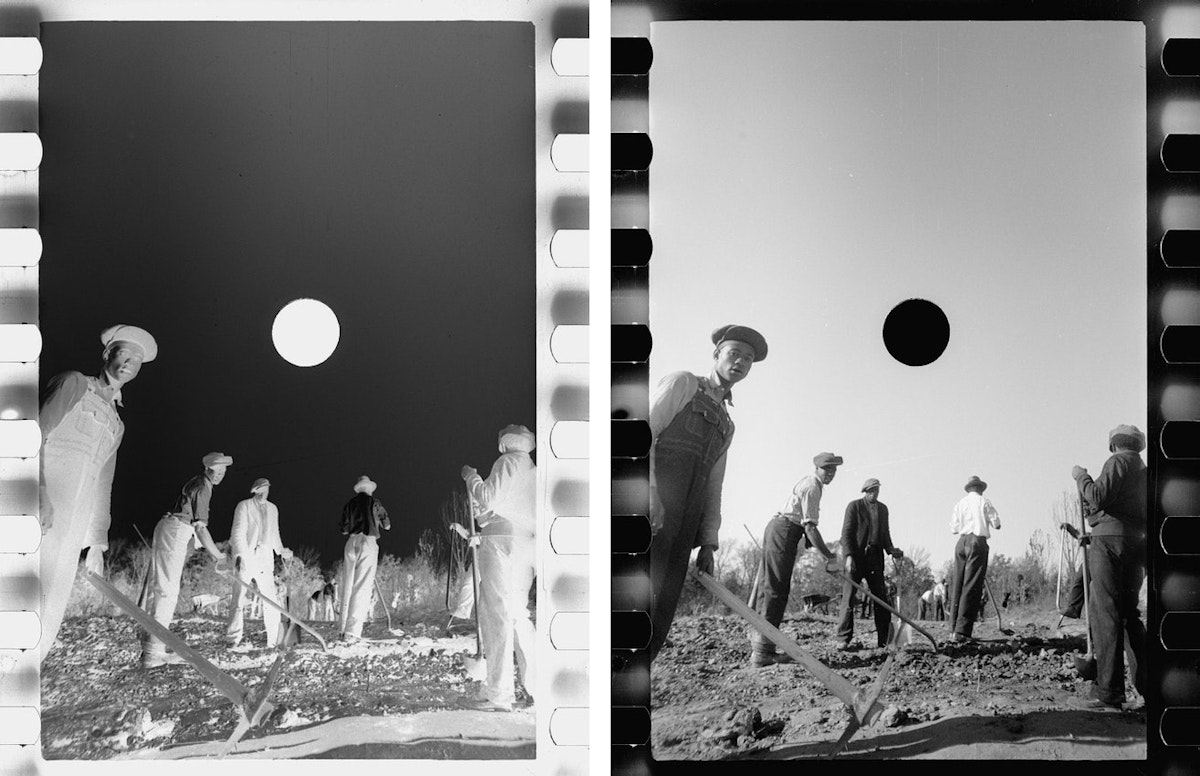 Scroll through the whole page to download all images before printing.
Scroll through the whole page to download all images before printing.Negative and positive view of an untitled photograph by Carl Mydans, 1935, possibly related to a series of images captioned: “Transients clearing land. Prince George's County, Maryland” — Source.
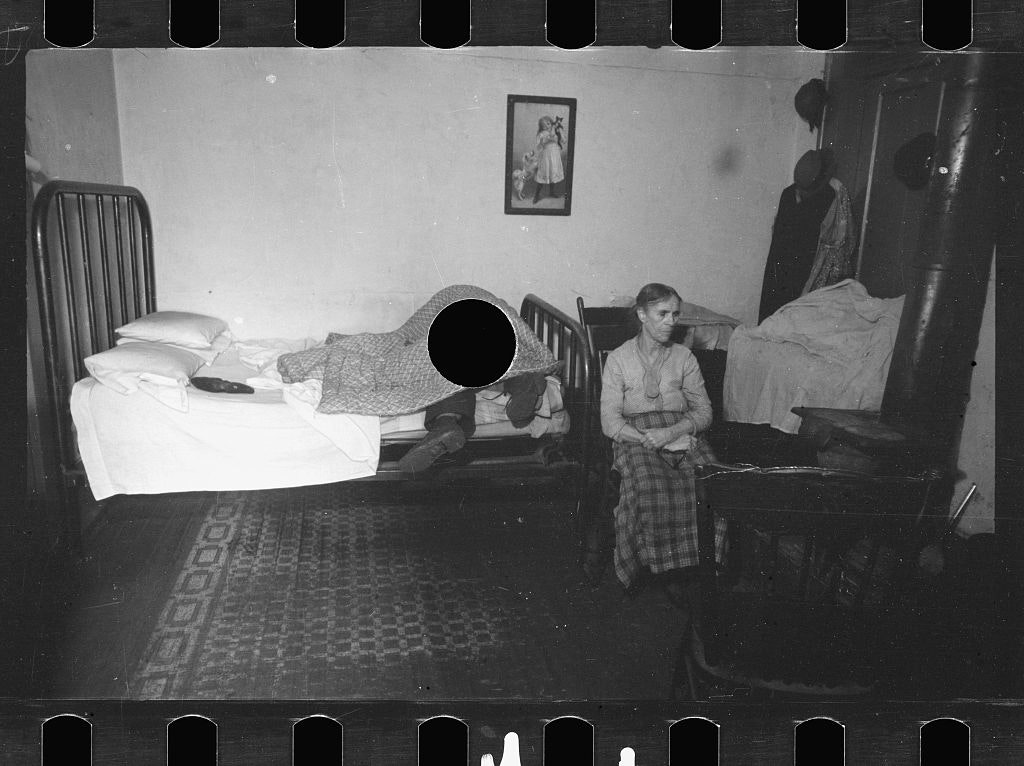 Scroll through the whole page to download all images before printing.
Scroll through the whole page to download all images before printing.Untitled photograph, unknown photographer and date — Source.
Punning on the pinhole history of early photographic technologies like the camera obscura, Roland Barthes used the word punctum (literally, “sting, speck, cut, little hole”) to name the disarming effect of certain images. “A photograph’s punctum”, he wrote, “is that accident which pricks me (but also bruises me, is poignant to me)”.13 In the killed negatives, we find Barthes’ dictum literalized: it is the little hole or holes themselves that arrest our eyes and imagination. The strange contradiction at the heart of the killed negatives — as the very existence of this essay attests — is that in an important sense they weren’t killed: the hole-punched photos remain in the Library of Congress, preserved by Stryker himself, and the Pittsburgh Photography Library images deemed unfit for the archives have instead come to comprise their own separate archive in the same building, a sort of Salon des Refusés. Allen Benson writes that the “entombment” of these images “produces a contradictory effect, a desire to look, to open the killed storage boxes and inspect the remains”.14 When we do look, we find that, whatever the organic center of the original photo’s gravity may be, the void has usurped it and become, suddenly, the focal point. In the subtle but unmistakable way that Stryker’s puncture marks reveal the three-dimensional negative from which each two-dimensional image is printed, they call our attention to the fact that a photograph is a physical object and a fragile one at that. And yet at the same time it’s difficult not to feel a visceral reel as a hole slices through the head of a child, the face of a young mother. Stryker’s rejects present us with a push-pull of mimesis: the scenes become less real even as they become more emotionally immediate.
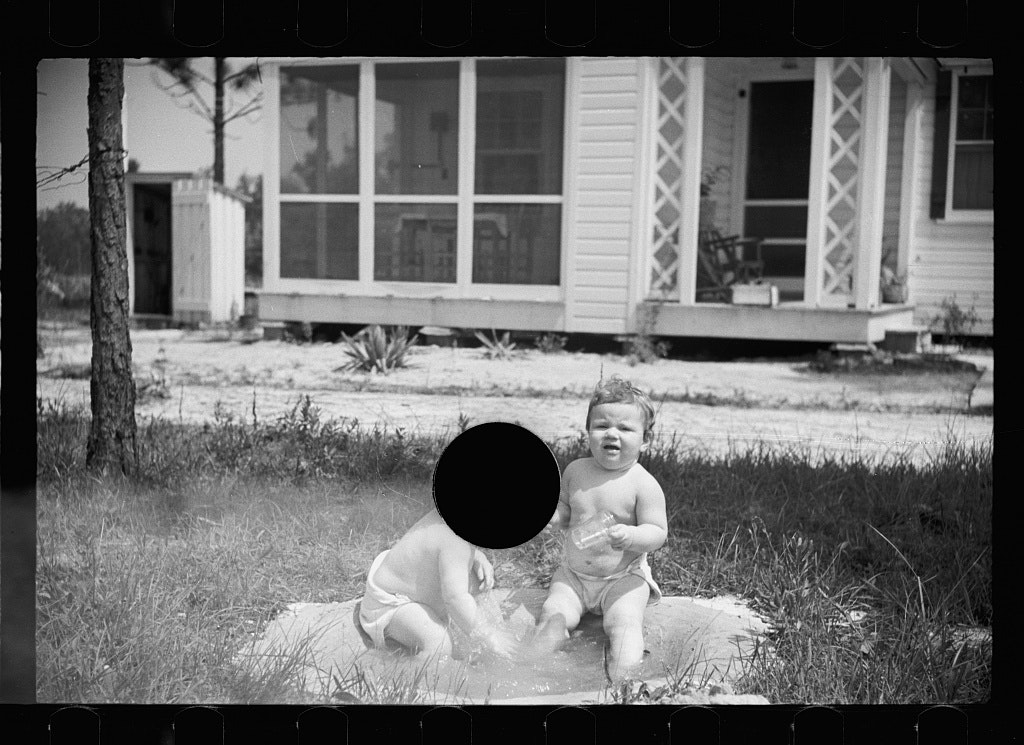 Scroll through the whole page to download all images before printing.
Scroll through the whole page to download all images before printing.Untitled photograph by Carl Mygans, 1936, of homesteaders’ children in Penderlea, North Carolina — Source.
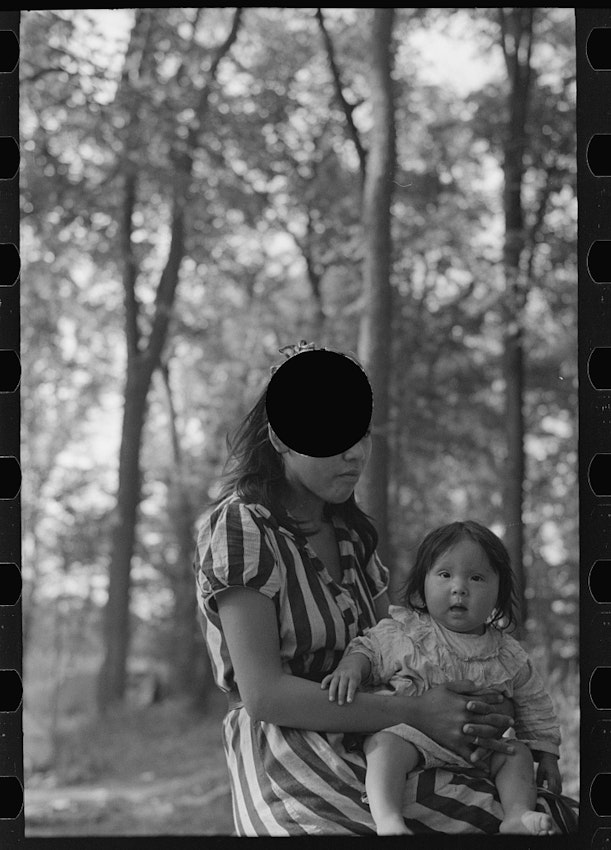 Scroll through the whole page to download all images before printing.
Scroll through the whole page to download all images before printing.Untitled photograph by Russell Lee, 1937, of a “young Indian mother and baby”, at Blueberry Camp, near Little Fork, Minnesota — Source.
If we wish to examine what images Stryker thought ultimately worthy of keeping, we must also consider the question of what images he thought were worth taking in the first place. Groups like Latinos and Native Americans, for instance, are underrepresented in the File.15 In a 1937 letter to Lange while she was on assignment photographing tenant farmers in Texas, Stryker advised her to “take both black and white, but place the emphasis on the white tenants, since we know that these will receive much wider use”.16 That latter part was indeed borne out by the fact that exhibitions and newspapers more readily selected white images from the File than non-white.17 More broadly, the FSA’s focus on the madonna, the stoic striver, elevated a certain class of “deserving poor” above those who were beyond the bounds both of being photographed and receiving material aid.18 For the government, of course, these two things were tightly interwoven: the purpose of the FSA’s photography program, after all, was to drum up support for the New Deal among an American public that had long viewed poverty as a moral stain. In the course of resettling white tenant farmers in the Mississippi Delta, the FSA forcibly uprooted Black families throughout the region — families whose suffering, it appears, did not rate high enough to make it into the File.19 When I viewed Stryker’s negatives together, they seemed to be posing questions not just about the work of the FSA but about the future of the country they sought to document: both “who should get a farm loan?” and “who cuts a heroic enough figure to advertise them?” Not only “whose grief do we recognize?”, but also “whose grief is deserving of succor?” Who will be kept and who will be killed? Who will survive in America — and what image of this land will these survivors bear into the future?
Erica X Eisen’s work has appeared in The Washington Post, The Guardian, The Baffler, n+1, The Boston Review, AGNI, and elsewhere. She received her bachelor’s degree in History of Art & Architecture from Harvard University with a focus on Japanese art and her MA in Buddhist Art History & Conservation from The Courtauld Institute of Art. She is an editor at Hypocrite Reader. Her writing can be found at www.ericaxeisen.com.

